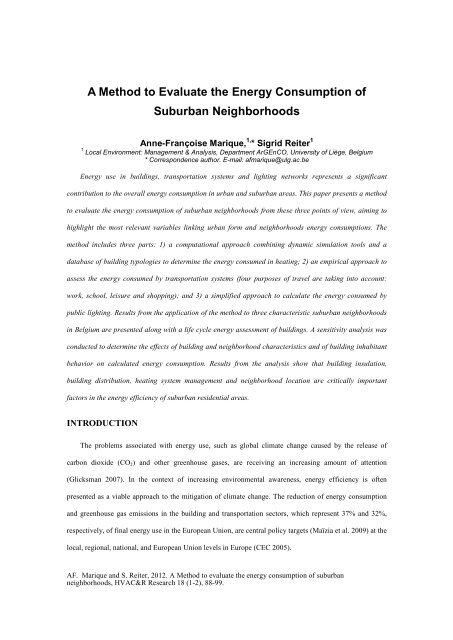Session 1 - Montefiore
Session 1 - Montefiore
Session 1 - Montefiore
Create successful ePaper yourself
Turn your PDF publications into a flip-book with our unique Google optimized e-Paper software.
A Method to Evaluate the Energy Consumption of<br />
Suburban Neighborhoods<br />
Anne-Françoise Marique, 1, * Sigrid Reiter 1<br />
1 Local Environment: Management & Analysis, Department ArGEnCO, University of Liège, Belgium<br />
* Correspondence author. E-mail: afmarique@ulg.ac.be<br />
Energy use in buildings, transportation systems and lighting networks represents a significant<br />
contribution to the overall energy consumption in urban and suburban areas. This paper presents a method<br />
to evaluate the energy consumption of suburban neighborhoods from these three points of view, aiming to<br />
highlight the most relevant variables linking urban form and neighborhoods energy consumptions. The<br />
method includes three parts: 1) a computational approach combining dynamic simulation tools and a<br />
database of building typologies to determine the energy consumed in heating; 2) an empirical approach to<br />
assess the energy consumed by transportation systems (four purposes of travel are taking into account:<br />
work, school, leisure and shopping); and 3) a simplified approach to calculate the energy consumed by<br />
public lighting. Results from the application of the method to three characteristic suburban neighborhoods<br />
in Belgium are presented along with a life cycle energy assessment of buildings. A sensitivity analysis was<br />
conducted to determine the effects of building and neighborhood characteristics and of building inhabitant<br />
behavior on calculated energy consumption. Results from the analysis show that building insulation,<br />
building distribution, heating system management and neighborhood location are critically important<br />
factors in the energy efficiency of suburban residential areas.<br />
INTRODUCTION<br />
The problems associated with energy use, such as global climate change caused by the release of<br />
carbon dioxide (CO2) and other greenhouse gases, are receiving an increasing amount of attention<br />
(Glicksman 2007). In the context of increasing environmental awareness, energy efficiency is often<br />
presented as a viable approach to the mitigation of climate change. The reduction of energy consumption<br />
and greenhouse gas emissions in the building and transportation sectors, which represent 37% and 32%,<br />
respectively, of final energy use in the European Union, are central policy targets (Maïzia et al. 2009) at the<br />
local, regional, national, and European Union levels in Europe (CEC 2005).<br />
AF. Marique and S. Reiter, 2012. A Method to evaluate the energy consumption of suburban<br />
neighborhoods, HVAC&R Research 18 (1-2), 88-99.











